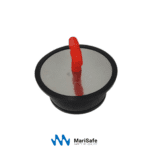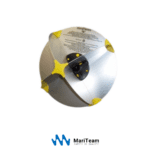Thermal Protective Aid (TPA) is an aluminized polyethylene suit with heat sealed seams that protects from the elements and prevents hypothermia.
It is defined by the International Life-Saving Appliance (LSA) Code as follows:
A thermal protective aid shall be made of a waterproof material having a thermal conductance of not more than 7,800 W/(m²K) and shall be so constructed that, when used to enclose a person, it shall reduce both the convective and evaporative heat loss from the wearer's body.
The thermal protective aid shall:
- Cover the whole body of persons of all sizes wearing a lifejacket with the exception of the face. Hands shall also be covered unless permanently attached gloves are provided;
- Be capable of being unpacked and easily donned without assistance in a survival craft or rescue boat; and
- Permit the wearer to remove it in the water in not more than 2 min, if it impairs ability to swim.
- The thermal protective aid shall function properly throughout an air temperature range -30°C to +20°C.
- Every survival craft should have 2 thermal protective aid suits or 10% of its total carrying capacity whichever is greater.
- For the purpose of high visibility in all weather conditions the suit is coloured in international orange.
International Convention for the Safety of Life at Sea (SOLAS)
The Thermal Protective Aid (TPA) is an essential component of maritime safety equipment, designed to prevent hypothermia and protect survivors from harsh environmental conditions during emergencies at sea. This SOLAS-compliant survival suit is constructed from aluminized polyethylene with heat-sealed seams, ensuring both durability and effective insulation.
Incorporating this TPA into your vessel's safety gear enhances preparedness and aligns with international maritime safety regulations. Its robust construction and practical design make it a vital component for ensuring crew survival during emergencies.
Technical Product Description:
Material: Aluminized polyethylene
Seams: Heat-sealed for waterproof integrity
Design: Sleeved suit with long zipper for easy donning
Compliance: Meets SOLAS requirements for lifeboat and liferaft equipment
Unique Selling Points:
Essential for Maritime Safety Compliance
Meets international standards, ensuring your vessel's safety equipment is up to code.
Durable and Waterproof Construction
Built to withstand the harsh marine environment, offering long-term reliability.
User-Friendly Design for Quick Deployment
Features a long zipper and sleeved design for rapid and easy donning during emergencies.
Compact and Easy to Store
Its lightweight and foldable design allows for convenient storage in emergency packs without adding unnecessary bulk.






